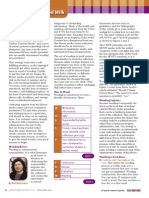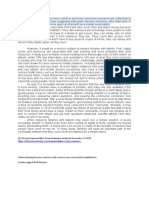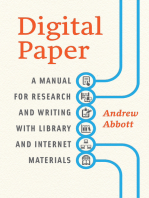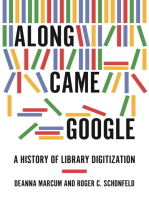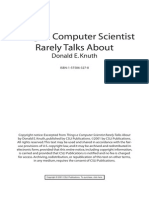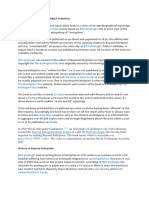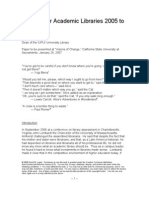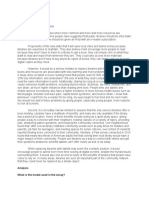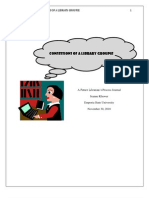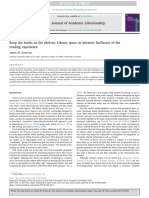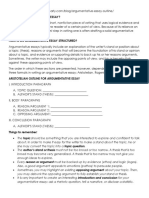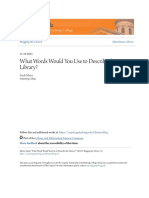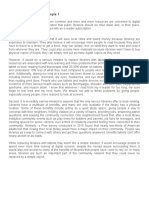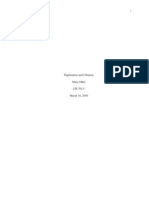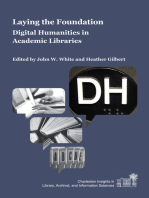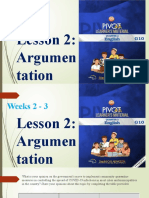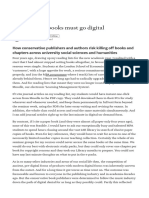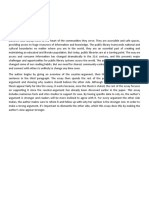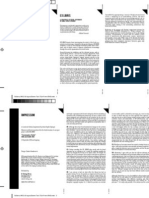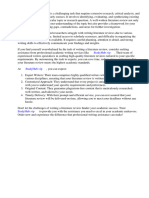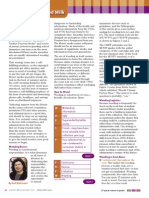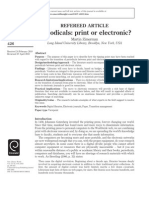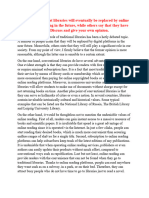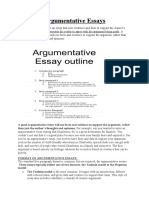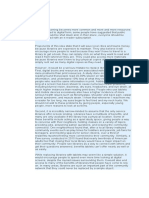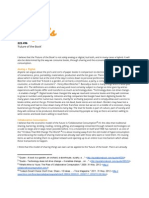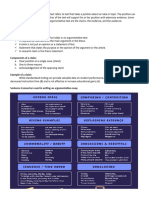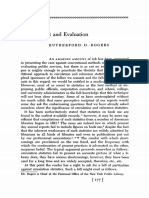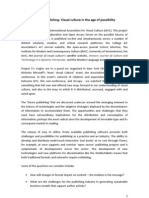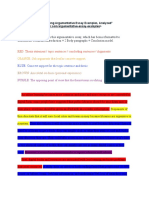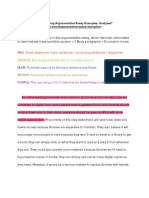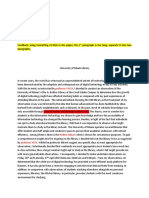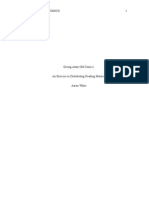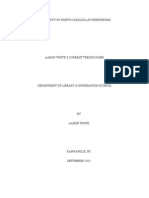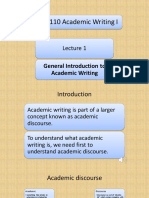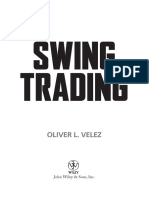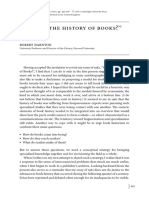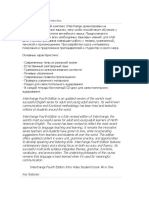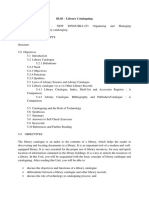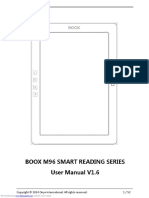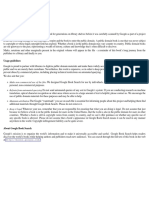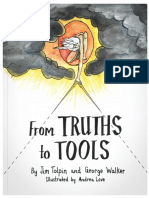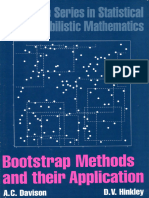0 ratings0% found this document useful (0 votes)
83 viewsAaronwhite'sresponsepaper
Aaronwhite'sresponsepaper
Uploaded by
api-280698285This document provides a reaction and analysis of David Lewis's article "From Stacks to the Web" which argues that libraries should transition away from print collections and toward digital collections and services. The response agrees that digital formats have advantages but is skeptical of arguments claiming print will be completely replaced. While subscription and on-demand models have benefits, print-on-demand may not satisfy lovers of print. Open access journals could reduce costs but established journals still have prestige that open access lacks. Overall the response urges caution against abandoning established infrastructure too quickly for unproven new models.
Copyright:
© All Rights Reserved
Available Formats
Download as DOCX, PDF, TXT or read online from Scribd
Aaronwhite'sresponsepaper
Aaronwhite'sresponsepaper
Uploaded by
api-2806982850 ratings0% found this document useful (0 votes)
83 views6 pagesThis document provides a reaction and analysis of David Lewis's article "From Stacks to the Web" which argues that libraries should transition away from print collections and toward digital collections and services. The response agrees that digital formats have advantages but is skeptical of arguments claiming print will be completely replaced. While subscription and on-demand models have benefits, print-on-demand may not satisfy lovers of print. Open access journals could reduce costs but established journals still have prestige that open access lacks. Overall the response urges caution against abandoning established infrastructure too quickly for unproven new models.
Original Description:
Original Title
aaronwhite'sresponsepaper
Copyright
© © All Rights Reserved
Available Formats
DOCX, PDF, TXT or read online from Scribd
Share this document
Did you find this document useful?
Is this content inappropriate?
This document provides a reaction and analysis of David Lewis's article "From Stacks to the Web" which argues that libraries should transition away from print collections and toward digital collections and services. The response agrees that digital formats have advantages but is skeptical of arguments claiming print will be completely replaced. While subscription and on-demand models have benefits, print-on-demand may not satisfy lovers of print. Open access journals could reduce costs but established journals still have prestige that open access lacks. Overall the response urges caution against abandoning established infrastructure too quickly for unproven new models.
Copyright:
© All Rights Reserved
Available Formats
Download as DOCX, PDF, TXT or read online from Scribd
Download as docx, pdf, or txt
0 ratings0% found this document useful (0 votes)
83 views6 pagesAaronwhite'sresponsepaper
Aaronwhite'sresponsepaper
Uploaded by
api-280698285This document provides a reaction and analysis of David Lewis's article "From Stacks to the Web" which argues that libraries should transition away from print collections and toward digital collections and services. The response agrees that digital formats have advantages but is skeptical of arguments claiming print will be completely replaced. While subscription and on-demand models have benefits, print-on-demand may not satisfy lovers of print. Open access journals could reduce costs but established journals still have prestige that open access lacks. Overall the response urges caution against abandoning established infrastructure too quickly for unproven new models.
Copyright:
© All Rights Reserved
Available Formats
Download as DOCX, PDF, TXT or read online from Scribd
Download as docx, pdf, or txt
You are on page 1of 6
UNIVERSITY OF NORTH CAROLINA AT GREENSBORO
REACTION TO
DAVID LEWISS FROM STACKS TO THE WEB
LIS 636
DEPARTMENT OF LIBRARY & INFORMATION SCIENCE
BY
AARON WHITE
KANNAPOLIS NC
OCTOBER 2013
Perhaps one way to engage David Lewiss positions is to focus on
his five conclusions.
1. Deconstruct Legacy Print Collections
Print has been superseded, or such is the belief underlying much
of this articles assertions. Whether reality is catching up with this
belief remains to be seen. The debate over print vs. digital is ongoing
and need not end with a winner-take-all resolution. My brother likes
having his whole library on a machine that fits in a drawer; his
girlfriend prefers the tactile engagement of paper. Perhaps the future
will accommodate them both instead of insisting that one yield to the
preferences of the other. If my brother is forced to return to paper, or
his girlfriend is forced to adopt digital, it shouldnt be overhasty
decisions by the library that forces them. Maybe print will go the way
of the LP and the videocassette, but such analogies are deceptive. The
heyday of the LP was about half a century long; that of the
videocassette was shorter. They were easily replaced by more robust
technological solutions. The codex, in contrast, has existed for
millennia. If it were easy to supersede, it probably would have been
before now.
Theres also room for skepticism about Michael Bucklands Three
Eras of the Library (Paper, Automated, and Electronic). If the library
becomes all digital soon, History may judge that the period of
automation is merely the end of Paper or the dawn of Electronic.
Furthermore, announcing the Third Stage of this theoretical
progression presumes the inevitability of an all-digital future that has
yet to manifest.
Without accepting the notion that digital will utterly replace
print, it does make sense to consider ways in which digital might be
the better option. Buckland is right that librarians need to focus on
what libraries do, rather than how they currently do it, and digital
formats, which allow for efficient removal and replacement of obsolete
information while still allowing long-term storage for archival purposes,
seem ideal for legal, medical, and technological information that cant
be expected to retain its value. Its sad to see big books about
Windows 95 taking up shelf space; better to keep such documents in
easily deletable form.
Its also exciting to think the long tail of print collections could be
preserved in print repositories and brought out on a need basis, saving
materials for posterity while freeing up space and making the
materials available for other area libraries. The price to be paid in
terms of browsability is an open question.
2. Move From Item-by-Item Book Selection to Purchaseon-Demand and Subscriptions
This is peculiar advice given Lewiss admonishment to shun Big
Deals when buying journals, since subscriptions are kissing cousins to
big deals. Both involve letting a vendor handle much of the selection.
The situation resembles the debate about cable channel bundling. On
the one hand, why should a cable customer pay for channels the
customer doesnt watch? On the other hand, the bundles provide
niche channels with enough of a safety net to keep them in business,
which supports diversity. Lewis presents similar arguments regarding
journal bundling A.K.A. Big Deals, and book subscriptions; whats odd
is that he seems to switch sides depending on whether hes discussing
journals or books.
Lewis is against Big Deals in journals, not only because of cost,
but waste.
He seems to argue that any journal that cant sustain
itself in subscription format should switch to open source, but he
doesnt apply the same logic to books. Here he believes a subscription
model will provide a financial safety net for niche texts. One mediums
safety net is another mediums waste; or is it? The arguments could
be switched around to argue for Open Source books or bundled fees
protecting the solvency of niche journals.
Lewiss belief that Print on Demand will fill any future desire for
print books is dubious. Ive not had the opportunity to try the POD
vending machines, but Ive purchased some POD books online, and
theyre no substitute for proper printing and binding. They are flimsy,
and they look like photocopies. Unless POD can improve its production
quality, lovers of print will be unsatisfied.
Artists monographs and other such books that rely on precise
production values might move to digital format if and when society
decides that paintings and photos are better engaged on computer
screens than in carefully designed books, but that day is not here, and
may never be.
Another cause for concern: much digital content to which
libraries lease access remains, essentially, the property of the vendor.
The librarys traditional preservation role is outsourced to vendors.
Open Source journals will probably reduce the problem on the journal
side (as seen in organizations like LOCKSS (Lots Of Copies Keep Stuff
Safe), but eBooks remain the property of the vendor.
3. Manage the Transition to Open Access Journals
Since my spouse works on Open Source software and regularly
publishes in Open Source journals, Id be delighted for Open Source to
conquer the world, but Im not sure its wise to join Mr. Lewis in
betting the farm on that outcome. Paywall journals such as Science,
Nature, and Cell are bywords in scientific research. Ive known
scientists who refused to submit to reputable OS journals like PLoS
One on the grounds that Ive published too much Open Source. It
makes it look like I cant get into a real journal.
4. Curate the Unique
This seems like a valuable way to ensure the ongoing and visible
relevance of the library to local communities. Collecting and
preserving materials that seem disposable, but are cultural artifacts, is
an established way for libraries to serve the community. For example,
zine libraries (such as the Bingham Center Zine Collections at Duke)
which curate collections of self-published magazines, prevent these
delicate artifacts of their time and place from becoming forgotten and
inaccessible. Perhaps one future of the library is the preservation of
other cultural expressions that are easily forgotten and lost, but which
help bear witness to the culture that created them. Zines are one
venue of grassroots expression. If libraries work to discover,
collaborate with, and preserve the creations of other local creative
cultures, it will serve the interests of the community and the library
while demonstrating the value of libraries to the cultural record. The
makerspaces that are becoming part of many libraries can serve this
mission.
5. Develop New Mechanisms to Fund National
Infrastructure
Its probably true that the funding of new library initiatives will
require creative fundraising and increased sharing. To what extent this
will be anything new is another open question. Its odd that Lewis
wants to jettison so much established infrastructure in order to replace
it with unproven new models for librarianship. He seems to want
libraries to make big gambles ASAP, in the fear that a slower pace will
leave libraries behind the times.
But time is relative: my hometown
public library adopted computerized catalogs (and in-library internet
access) several years after Id first used Netscape to access the World
Wide Web. As soon as they did, a local politician tried to score points
by chastising the library for providing children access to pornography;
he threatened to cut the librarys public funding. Perhaps the library
moved too fast. For several years thereafter, the card catalog
remained in the lobby, with little signs warning that it was no longer
being updated. The library is still there, and probably doing well. Did
it move to fast on embracing computers and abandoning the card
catalog? Did it move too slowly? Either way, it is still in business.
You might also like
- Foundations of Library and Information Science (Richard Rubin, Rachael Rubin)Document1,069 pagesFoundations of Library and Information Science (Richard Rubin, Rachael Rubin)kashiflibrarian100% (2)
- Platinum Creative Arts. Grade 7, Learner's Book (Brown, A.) (Z-Library)Document320 pagesPlatinum Creative Arts. Grade 7, Learner's Book (Brown, A.) (Z-Library)Lorna Harris70% (10)
- Dickinson Crying Over Spilled MilkDocument4 pagesDickinson Crying Over Spilled Milkcj1900100% (5)
- As Online Learning Becomes More Common and More and More Resources Are Converted To Digital FormDocument3 pagesAs Online Learning Becomes More Common and More and More Resources Are Converted To Digital FormIrish Gamboa Duenas71% (14)
- Introduction To Politics and International Relations PDFDocument52 pagesIntroduction To Politics and International Relations PDFyikil2100% (1)
- Digital Paper: A Manual for Research and Writing with Library and Internet MaterialsFrom EverandDigital Paper: A Manual for Research and Writing with Library and Internet MaterialsRating: 4 out of 5 stars4/5 (5)
- Along Came Google: A History of Library DigitizationFrom EverandAlong Came Google: A History of Library DigitizationRating: 3.5 out of 5 stars3.5/5 (6)
- Library Assignment #2 - Fall 2021 - Student-1Document6 pagesLibrary Assignment #2 - Fall 2021 - Student-1dyna ruzethNo ratings yet
- Things A Computer Scientist Rarely Talks AboutDocument26 pagesThings A Computer Scientist Rarely Talks AboutmaksimuNo ratings yet
- Azes Publishing - Printer-Publisher AgreementDocument10 pagesAzes Publishing - Printer-Publisher AgreementPending_nameNo ratings yet
- 2021.10.02 Everipedia Page - Beyond EnkriptionDocument4 pages2021.10.02 Everipedia Page - Beyond EnkriptionBoris JohnsonNo ratings yet
- Information Architecture, Blueprints For The Web 2nd Edition (2009)Document313 pagesInformation Architecture, Blueprints For The Web 2nd Edition (2009)arkngelus100% (2)
- A Model For Academic LibrariesDocument22 pagesA Model For Academic LibrariesTeresa RebeloNo ratings yet
- Activity in English 10 (Argumentative)Document2 pagesActivity in English 10 (Argumentative)Aya LarosaNo ratings yet
- Book Availability Revisited: Turnaround Time For Recalls Versus Interlibrary LoansDocument18 pagesBook Availability Revisited: Turnaround Time For Recalls Versus Interlibrary Loansgfc08No ratings yet
- LIB 801 JournalDocument27 pagesLIB 801 Journalkliewerj32No ratings yet
- Library TermsDocument37 pagesLibrary TermsBea JalipaNo ratings yet
- Keep The Books On The Shelves Library Space As IntDocument7 pagesKeep The Books On The Shelves Library Space As IntKhristine CocsonNo ratings yet
- What Is An Argumentative Essay?: Things To RememberDocument4 pagesWhat Is An Argumentative Essay?: Things To RememberUnique CiriacoNo ratings yet
- What Words Would You Use To Describe The LibraryDocument4 pagesWhat Words Would You Use To Describe The LibraryKhadija HalbNo ratings yet
- Academic E-Books: Publishers, Librarians, and UsersFrom EverandAcademic E-Books: Publishers, Librarians, and UsersRating: 3 out of 5 stars3/5 (1)
- LW Achiever Argumentative Essay Example 1 Wiith AnalysisDocument2 pagesLW Achiever Argumentative Essay Example 1 Wiith AnalysisSliezyyNo ratings yet
- Libraries and Digitization TodayDocument7 pagesLibraries and Digitization Todayapi-166902455No ratings yet
- Laying the Foundation: Digital Humanities in Academic LibrariesFrom EverandLaying the Foundation: Digital Humanities in Academic LibrariesRating: 3 out of 5 stars3/5 (1)
- Lesson 2 - ArgumentationDocument30 pagesLesson 2 - ArgumentationJanet BandojanNo ratings yet
- On Duty at the Info Desk: Strategies and Best Practices forLibrary Reference and Information ServicesFrom EverandOn Duty at the Info Desk: Strategies and Best Practices forLibrary Reference and Information ServicesNo ratings yet
- Books vs. Internet Research PaperDocument6 pagesBooks vs. Internet Research Paperadgecibkf100% (1)
- All Academic Books Must Go Digital by Writing For Research AdviceDocument10 pagesAll Academic Books Must Go Digital by Writing For Research AdvicebeshirdesalegnNo ratings yet
- Maria Nessa V. Baldomero Bs-Criminology Crim1BDocument1 pageMaria Nessa V. Baldomero Bs-Criminology Crim1BMarianessa BaldomeroNo ratings yet
- Dispelling Five Myths About E-BooksDocument7 pagesDispelling Five Myths About E-BooksNemanja JelenicNo ratings yet
- Traditional Library Versus New Technology Such As eDocument10 pagesTraditional Library Versus New Technology Such As eAnonymous fjFtyLiNo ratings yet
- Critical Reading ExerciseDocument2 pagesCritical Reading ExerciseFazzar Khoirull ImanNo ratings yet
- Literature Review Example Step by Wicked StepDocument4 pagesLiterature Review Example Step by Wicked Stepiimytdcnd100% (1)
- EX LIBRIS: Commonplace BooksDocument2 pagesEX LIBRIS: Commonplace BooksToronto1230% (2)
- 8 - M16 - Composition2, Lecture 8, Pr. AglizDocument5 pages8 - M16 - Composition2, Lecture 8, Pr. AglizSido MamtoNo ratings yet
- Concordia Library Literature ReviewDocument8 pagesConcordia Library Literature ReviewcjxfjjvkgNo ratings yet
- Ucd Library Literature ReviewDocument5 pagesUcd Library Literature Reviewafmzydxcnojakg100% (1)
- Dickinson April May2005Document3 pagesDickinson April May2005rajeshkannanspNo ratings yet
- Cruz Maria Ines Rossenova Lozana Eds Bookspace Collected Essays On Libraries 2015Document136 pagesCruz Maria Ines Rossenova Lozana Eds Bookspace Collected Essays On Libraries 2015Joan X. VázquezNo ratings yet
- Will Public Libraries Become ExtinctDocument3 pagesWill Public Libraries Become ExtinctMatias GuerreroNo ratings yet
- Transforming Libraries: A Toolkit for Innovators, Makers, and SeekersFrom EverandTransforming Libraries: A Toolkit for Innovators, Makers, and SeekersNo ratings yet
- Periodicals PrintDocument8 pagesPeriodicals PrintArun VaresseriNo ratings yet
- Topic 8Document2 pagesTopic 8123 dunchNo ratings yet
- Argumentative EssaysDocument4 pagesArgumentative EssaysZofishan Khan0% (1)
- Argumentative EssayDocument2 pagesArgumentative EssayChiesa ArellanoNo ratings yet
- A Bibliography for the Libro de buen amor, E-Book VersionFrom EverandA Bibliography for the Libro de buen amor, E-Book VersionNo ratings yet
- Digital Library System Literature ReviewDocument4 pagesDigital Library System Literature Reviewafmzxutkxdkdam100% (1)
- Exegesis: Future of The Book'Document5 pagesExegesis: Future of The Book'nowthatsmintNo ratings yet
- Bookreview2 Expectmore SarahmarshallDocument8 pagesBookreview2 Expectmore Sarahmarshallapi-315614888No ratings yet
- Digital Library Literature ReviewDocument7 pagesDigital Library Literature Reviewea813c29100% (1)
- Sample Argumentative TextDocument3 pagesSample Argumentative TextMerry Heart CabarlesNo ratings yet
- Measurement and Evaluation: Rutherford RogersDocument11 pagesMeasurement and Evaluation: Rutherford RogersBensonNo ratings yet
- Morris & Sibert (2011)Document33 pagesMorris & Sibert (2011)Matias GuerreroNo ratings yet
- Future Publishing Visual Culture in The Age of PossibilityDocument33 pagesFuture Publishing Visual Culture in The Age of PossibilitydzjanNo ratings yet
- Argumentative Essay Color CodeDocument3 pagesArgumentative Essay Color CodeViola LeeNo ratings yet
- Scenarios2012 PDFDocument36 pagesScenarios2012 PDFFaustin NgutraNo ratings yet
- Argumentative Essay Color Code-1Document3 pagesArgumentative Essay Color Code-1Viola LeeNo ratings yet
- Use of LibraryDocument8 pagesUse of LibraryMAKINDE KOLAWOLE MOSESNo ratings yet
- The Intellectual Foundation of Information OrganizationDocument3 pagesThe Intellectual Foundation of Information OrganizationLeonora DuarteNo ratings yet
- Evolving Space An Examination of Coffee Shops in Academic LibrariesDocument30 pagesEvolving Space An Examination of Coffee Shops in Academic Librariesantonette loriagaNo ratings yet
- Feedback: Using Formatting of MLA in The Paper The 1 Paragraph Is Too Long, Separate It Into Two ParagraphsDocument3 pagesFeedback: Using Formatting of MLA in The Paper The 1 Paragraph Is Too Long, Separate It Into Two ParagraphsjohnmccauleyNo ratings yet
- The History of the Implementation of the Library Computer System (LCS) at the University of Illinois at Urbana-ChampaignFrom EverandThe History of the Implementation of the Library Computer System (LCS) at the University of Illinois at Urbana-ChampaignNo ratings yet
- 801 SUMMERS JournalDocument34 pages801 SUMMERS Journalbsummer4No ratings yet
- Transforming Acquisitions and Collection Services: Perspectives on Collaboration Within and Across LibrariesFrom EverandTransforming Acquisitions and Collection Services: Perspectives on Collaboration Within and Across LibrariesMichelle FlinchbaughNo ratings yet
- Aaron White's Group Process Evaluation/AnalysisDocument6 pagesAaron White's Group Process Evaluation/Analysisapi-280698285No ratings yet
- Aaronwhitesassignment 2 PaperDocument15 pagesAaronwhitesassignment 2 Paperapi-280698285No ratings yet
- Giving Away Old Comics 1Document22 pagesGiving Away Old Comics 1api-280698285No ratings yet
- Aaron White's Assignment 1 University of North Carolina at GreensboroDocument6 pagesAaron White's Assignment 1 University of North Carolina at Greensboroapi-280698285No ratings yet
- Aaron White's Current Trends PaperDocument13 pagesAaron White's Current Trends Paperapi-280698285No ratings yet
- Your Money Personality Unlock The Secret To A Rich and Happy LifeDocument30 pagesYour Money Personality Unlock The Secret To A Rich and Happy LifeLiz Koh100% (1)
- MIL - Q3 - Mod5 - Types of Media (Print, Broadcast, Online)Document10 pagesMIL - Q3 - Mod5 - Types of Media (Print, Broadcast, Online)Yeng Lugtu50% (2)
- Oxford Bookworms Library Starter Level: Dead Man's Money - Oxford University PressDocument2 pagesOxford Bookworms Library Starter Level: Dead Man's Money - Oxford University Pressliha abidar0% (1)
- UGRC 110 Complete Lecture Slides 2Document211 pagesUGRC 110 Complete Lecture Slides 2Muel OpokuNo ratings yet
- Masters of Science Fiction and Fantasy Art A Collection of The Most Inspiring Science Fiction, Fantasy, and Gaming... (Karen Haber) (Z-Library)Document224 pagesMasters of Science Fiction and Fantasy Art A Collection of The Most Inspiring Science Fiction, Fantasy, and Gaming... (Karen Haber) (Z-Library)Juan Alvarez MenesesNo ratings yet
- John Wiley & Sons, IncDocument9 pagesJohn Wiley & Sons, IncSubhash DhakarNo ratings yet
- The Abc of Stock Speculation by S A Nelson PDFDocument249 pagesThe Abc of Stock Speculation by S A Nelson PDFDivya MukhopadhyayNo ratings yet
- 18 Best Sites To Download Free Books in 2023Document22 pages18 Best Sites To Download Free Books in 2023XtianNo ratings yet
- Darton. What Is The History of Books PDFDocument14 pagesDarton. What Is The History of Books PDFDaniel LopezNo ratings yet
- Make Your Words Sell PDFDocument251 pagesMake Your Words Sell PDFרובייט רוניNo ratings yet
- Yale University Press World Languages 2011Document38 pagesYale University Press World Languages 2011Yale University Press0% (1)
- Advance OneDocument20 pagesAdvance OneBryant JimenezNo ratings yet
- BLIS - Library CataloguingDocument19 pagesBLIS - Library CataloguingSantosh GuptaNo ratings yet
- Boox M96 Smart Reading Series User Manual V1.6: Downloaded From Manuals Search EngineDocument52 pagesBoox M96 Smart Reading Series User Manual V1.6: Downloaded From Manuals Search EngineLucíaNo ratings yet
- Holiday HW - Vi-X - 2023-24Document12 pagesHoliday HW - Vi-X - 2023-24kalavathi1289No ratings yet
- Dutch and Flemish FurnitureDocument476 pagesDutch and Flemish FurnitureJo-Leigh LyonsNo ratings yet
- 378 High Frequency Words in IELTS ListeningDocument7 pages378 High Frequency Words in IELTS ListeningHannah0% (1)
- Hku Thesis BindingDocument5 pagesHku Thesis Bindingmcpvhiief100% (2)
- From Truths To ToolsDocument209 pagesFrom Truths To ToolsvpcNo ratings yet
- The History of JavaDocument582 pagesThe History of JavaDonald Essen100% (1)
- Prospectus 22 23Document110 pagesProspectus 22 23Harsh GossainNo ratings yet
- Davison Hinkley Bootstrap Methods and Their ApplicationDocument596 pagesDavison Hinkley Bootstrap Methods and Their ApplicationthyagosmesmeNo ratings yet
- Daily Lesson Plan Year 2: AttendanceDocument44 pagesDaily Lesson Plan Year 2: AttendancesuthasenasendramNo ratings yet
- Book ReviewDocument3 pagesBook ReviewSirElwoodNo ratings yet


